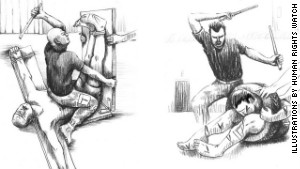Human Rights Watch has released a report on Syria’s state policy of torture, which includes testimony from former prisoners and security officers, while also revealing that among the victims are women, senior citizens and children. However, Syria’s government routinely denies all allegations of any such abuse.
“Basat al reeh.” “Dulab.” “Falaqa.” They are Arabic names for torture techniques that send chills through the hearts of Syrians, particularly the untold thousands who are believed to have been detained during the uprising of the last 15 months.”We suffered torture all the time,” said Tariq, an opposition activist from the port city of Latakia who spent 40 days in solitary confinement in spring 2011.
He told CNN he endured “dulab,” in which torturers force the prisoner’s legs and head into a car tire before beating them, and “basat al reeh,” in which the prisoner is tied to a board and beaten.
“They threw cold water on our naked bodies and they also urinated on us … they are really good at what they do,” said Tariq, who fled to Turkey and is now helping to

mobilize men and weapons to rebels inside Syria.
Human Rights Watch has so far identified as many as 27 detention centers throughout Syria where torture is systematically inflicted on prisoners, according to testimonies from more than 200 former prisoners and security officers who defected.
“It is a network of torture chambers that the authorities are using to intimidate and punish people who dare to oppose the government,” Ole Solvang, a researcher for Human Rights Watch, reported .”Nobody knows how many people are being detained, how many are being tortured,” he added. “But one local activist group has collected names of 25,000 people in detention. The numbers are absolutely staggering.”
The Human Rights Watch report includes satellite maps showing the exact location of detention centers and lists the names of commanders of individual detention centers. Human Rights Watch is urging the U.N. Security Council to refer Syrian officials to the International Criminal Court for alleged crimes against humanity.
“Those who commit these abuses do so with complete impunity, thinking they will never have to answer for this,” Solvang said. “By publishing these names, we are really putting them on notice, saying they will have to answer for these violations.”
US Secretary of State, Hillary Clinton, says that though there is no guarantee of a positive outcome, there is, however, a plan for Syrian transition in the works.
Annan discusses latest action on Syria